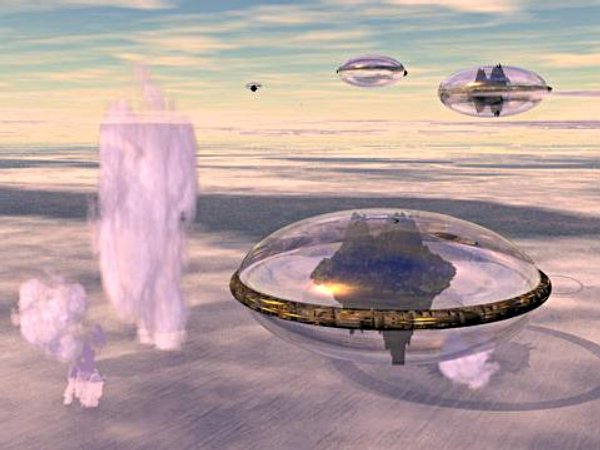BY LETTER
Vacuum Dirigibles
Technology > Application > Transportation > Atmospheric Transport
Technology > Technology Type or Material > Drytech/Hylotech
Technology > Technology Levels > High Tech / Hitech
Technology > Technology Type or Material > Drytech/Hylotech
Technology > Technology Levels > High Tech / Hitech
Cloud Cities on Cumulus |
 Image from Todd Drashner |
Lighter-than-air flying machines built around the use of nanotech constructed materials. Vacuum dirigibles use the ability of nanotechnology to create lightweight fabric-like materials that are strong enough to hold their shape and contain a low-pressure or even vacuum-equivalent region against the pressure of an external atmosphere. Using this technology it is possible to create a lighter- than-air lifting body without the necessity of gases such as hydrogen or helium, or a heating element.
Vacuum Balloons
These are large balloons containing vacuum which are used singly or in groups; compression by the atmosphere means that these balloons must follow certain design constraints.The structure containing the vacuum must be strong in compression, as the surface is subjected to the ambient atmospheric pressure. Suitable structures include most regular solids, and geodesic spheres of various kinds; however the closer the structure is to a spherical shape, the more likely it is to buckle. The strongest vacuum balloon is in fact a tetrahedron. Other shapes benefit from lightweight internal bracing, either arranged radially or using a regular framework, often tetrahedral or cubical in arrangement. Nano-assembled, effectively flawless diamondoid material is very strong in compression so can be used for very lightweight, strong internal bracing. One very strong allotrope of carbon is ACN, aggregated carbon nanorod material, which can be stronger in compression than any other conventional material if nanofactured correctly.
Aerovac foam
Instead of large vac-balloons, many vacuum dirigibles use aerovac foam instead. Foam of this kind, consisting of tiny lightweight bubbles containing vacuum, is considerably more convenient for many purposes, and the foam can easily be replenished when necessary.Rather than a hard vacuum, some designs of balloon use low pressure gas (generally helium) to reduce the required strength of the balloon structure. Of course the use of helium gas at normal pressure (that is to say in regular high pressure helium balloons in tension) is widespread in Earth-like atmospheres containing mostly nitrogen and oxygen. The difference between the lift available from helium and the maximum possible lift from a vacuum balloon is very small. If the lift from pure vacuum (disregarding the weight of the balloon structure) is considered to be 1 unit in an Earth-like atmosphere, then the lift from hydrogen is 0.93 units and from helium 0.86 units. This obviously constrains the weight of the balloon structure to be very small indeed, if the total lift is to be greater than that afforded by helium or hydrogen.
In the atmosphere of a gas giant this tiny advantage is useful, as a typical gas giant's atmosphere is mostly hydrogen and helium, and has a very low density. Only vacuum balloons, or heated hydrogen or helium can be used. In fact the same designs which are used for vac-balloons are also useful for certain kinds of hot helium balloons, as diamondoid is not only strong in compression but also has a high melting point.
Vacuum dirigibles are ubiquitous in many nanotech capable areas. They range in size from insect-sized units supporting small sensor or effector platforms, to huge, multi-volume arrays carrying entire communities above the ground.
Related Articles
Appears in Topics
Development Notes
Text by Todd Drashner with additions by Steve Bowers
Initially published on 16 February 2004.
Initially published on 16 February 2004.






